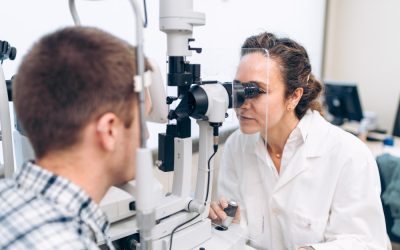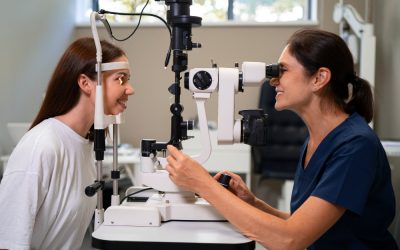Understanding Presbyopia: What Is It and Why Does It Occur?

Presbyopia is a common problem that comes with aging. It makes it hard to see things up close. This usually becomes noticeable around age 40. In this blog, we will break down presbyopia: what is it exactly, why it happens, and its main symptoms. We’ll also explore the different treatment options available.
Defining Presbyopia: What Is It and How Does It Affect Vision?
Presbyopia: what is it? Simply put, presbyopia is an issue with your vision due to aging. It happens because the lens inside your eye loses its flexibility. This is a refractive error, meaning it affects how light bends into your eye. When this lens becomes less flexible, it’s harder to focus on things up close. Most people start to notice signs after 40. It slowly gets worse over the years.
This change in the eye is totally natural but can be inconvenient for daily tasks like reading or using a smartphone. As we age, the eye’s flexibility reduces due to the hardening of the lens. This impacts the eye’s ability to focus on close objects, which makes seeing small print a challenge.
The Science Behind Presbyopia
To understand presbyopia: what is it, we dive into the eye’s anatomy. Within the eye, the lens and the ciliary muscles work together to help us see things at different distances. These muscles change the shape of the lens to focus light properly. As we age, the lens becomes harder and the muscles weaken, making this process less effective.
Here’s a basic comparison:
- Presbyopia: Difficulty focusing on close objects due to the aging of the eye lens.
- Nearsightedness: Objects nearby are clear, but far objects are blurry.
- Farsightedness: Far objects are clear, but close objects are blurry.
With presbyopia: what is it, you might start holding books or other reading materials further away to see clearly. This is because the light isn’t bending properly without the lens’s help. Understanding how this happens helps us appreciate the natural aging process and its impact on vision.
Causes and Risk Factors of Presbyopia
The main cause of presbyopia is aging, which leads to the structural changes in the eye that affect the lens and ciliary muscles. However, some other factors can increase the risk of early presbyopia:
- Medical conditions: Diabetes, heart diseases, and multiple sclerosis can predispose individuals to presbyopia.
- Medications: Some medications, especially those for antidepressants or antihistamines, could increase your risk.
- Lifestyle: Regular exposure to sunlight without protection, smoking, or excessive screen time may speed up its onset.
Even though you can’t avoid aging, you can take steps to potentially delay early onset, such as wearing sunglasses, quitting smoking, and reducing screen time.
Recognizing and Understanding the Symptoms of Presbyopia
When presbyopia: what is it, symptoms become noticeable, they often include:
- Trouble reading small print.
- Needing brighter light to see clearly.
- Experience of eyestrain or headaches after reading or using screens for long periods.
These symptoms affect daily activities. Recognizing these signs early can help in managing the initial discomfort. If you start experiencing such symptoms, it’s advisable to consult an eye care professional.
Diagnosing Presbyopia: What to Expect
If you suspect presbyopia: what is it, here’s a look at what an eye examination might involve:
- Visual acuity test: This checks how well you see from various distances.
- Refraction test: Determines your precise eyeglass prescription as it changes over time.
An eye doctor will use these tests to diagnose presbyopia. Early detection can lead to better management, preventing too much trouble in your daily life.
Exploring Treatment Options for Presbyopia
Several treatment options can help manage presbyopia: what is it. Here are some common solutions:
- Eyeglasses: Reading glasses or bifocals can help correct close-up vision.
- Contact lenses: Options like bifocal contact lenses or monovision lenses, where one lens is for distance and the other for near vision.
- Surgical options: Procedures such as LASIK or lens implants can offer more permanent solutions.
Recently, there have been emerging topical treatments that promise new ways to improve vision. Choosing the right treatment depends on your lifestyle and what you’re comfortable with. An eye care professional can help guide you in making the best choice.
Living with Presbyopia: Tips and Tricks
Living with presbyopia: what is it doesn’t have to be challenging. Here are some simple tips to help manage:
- Improve lighting in your work and living spaces.
- Take regular breaks when using screens to prevent eyestrain.
- Use magnifying tools for hobbies that require close-up vision.
Embrace these age-related changes while seeking effective solutions to enhance your daily life. Maintaining a positive outlook can make adapting to these changes easier.
Conclusion: Embracing and Managing Presbyopia
In conclusion, presbyopia: what is it is a natural part of aging. It impacts the ability to see close objects clearly. But understanding why it occurs and recognizing its symptoms early can make management easier. There are plenty of treatment options, from simple reading glasses to surgical solutions, to help ease the inconveniences.
Don’t hesitate to seek professional advice for tailored solutions suited to your needs. Presbyopia is something many people deal with, and with the right approach and mindset, it can be managed effectively. Remember, it’s just a part of life’s journey with practical solutions available.
If you’re experiencing difficulty seeing close objects clearly, don’t let presbyopia hold you back. At Global Eye Hospital, our experienced specialists can help you explore the best treatment options, from reading glasses to advanced surgical solutions, tailored to your specific needs.
Book an appointment today and take the first step toward clearer vision! Visit our website or call [insert contact details] for more information. Your eye health matters—let us help you see life more clearly!


